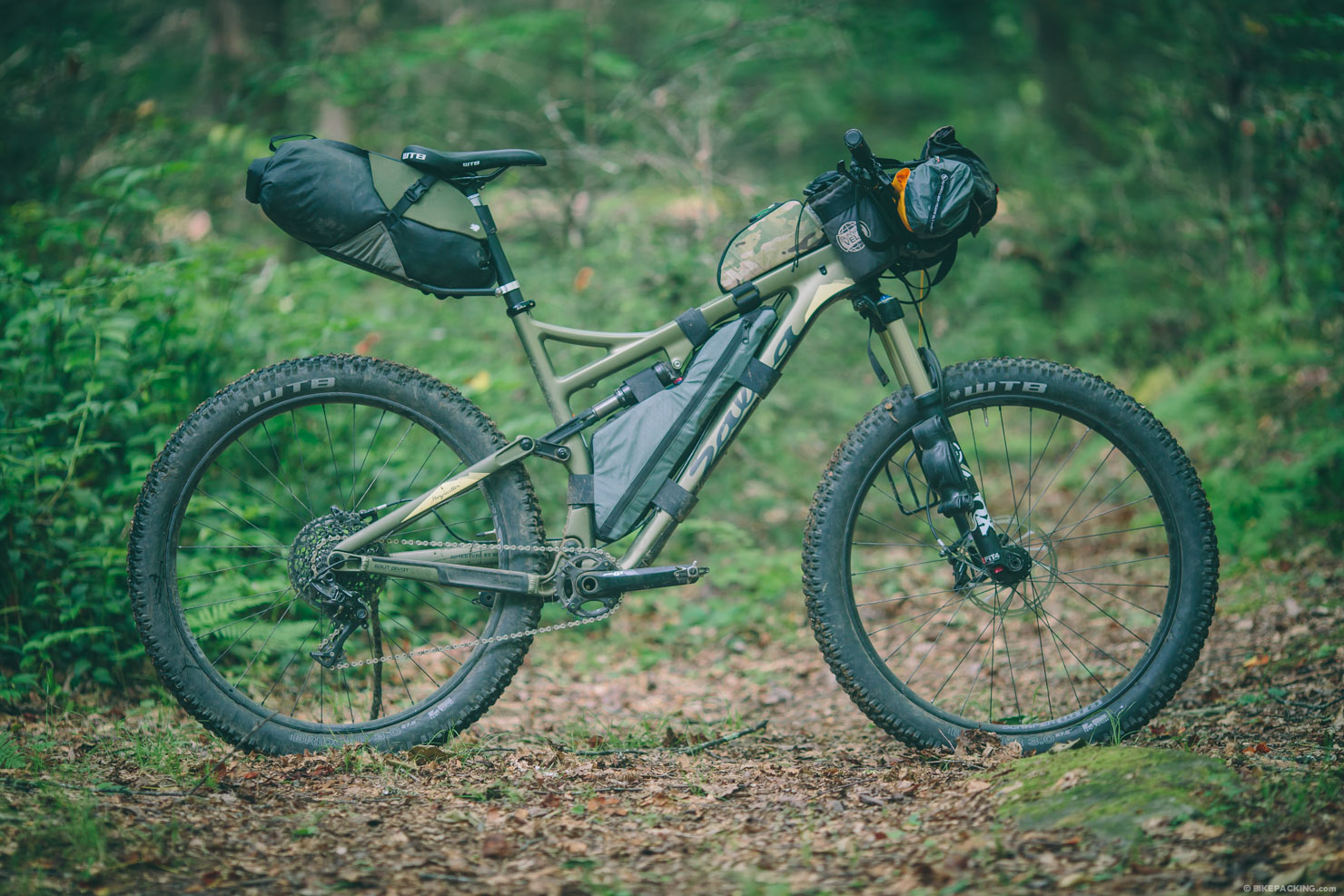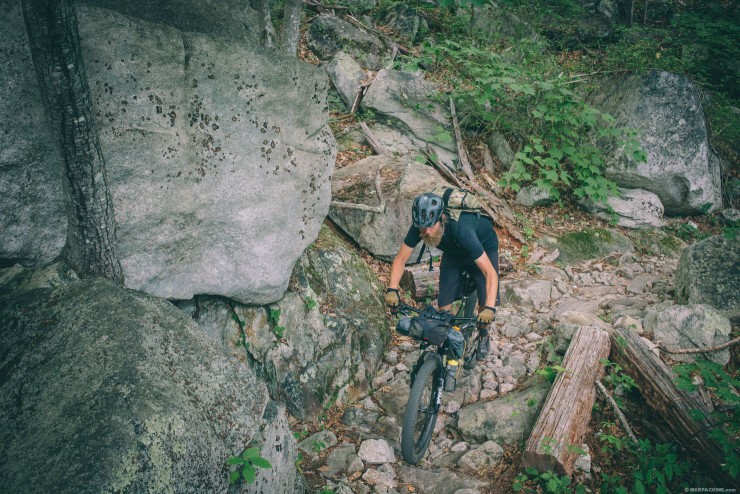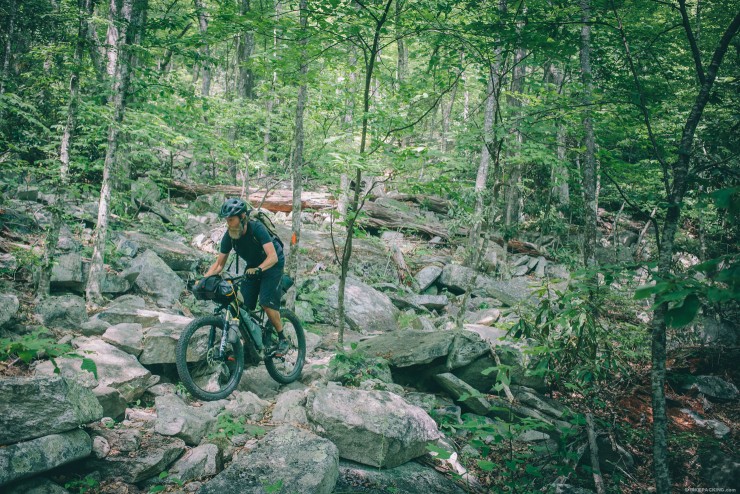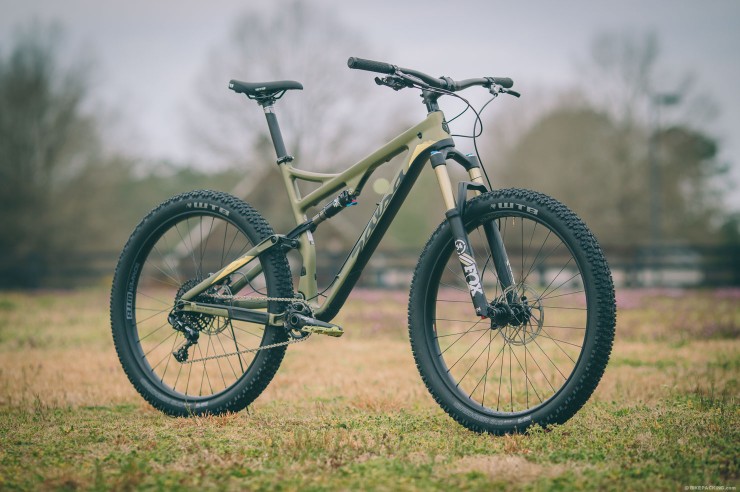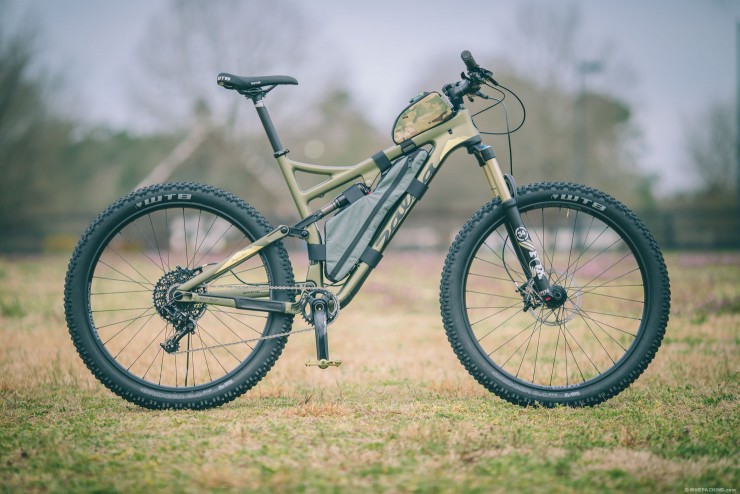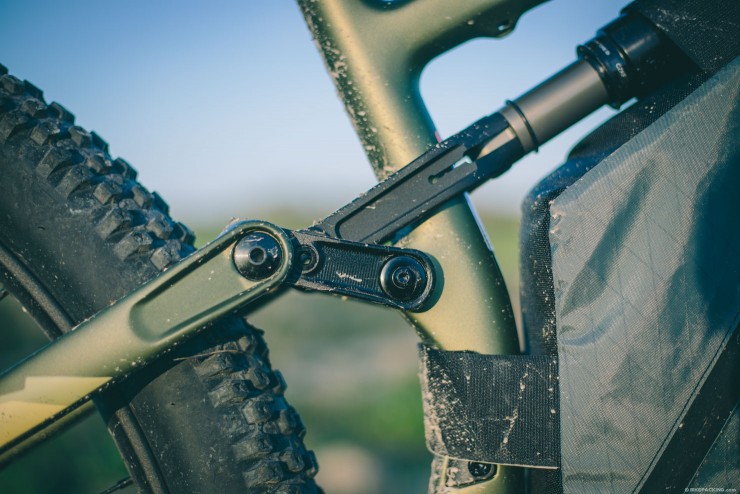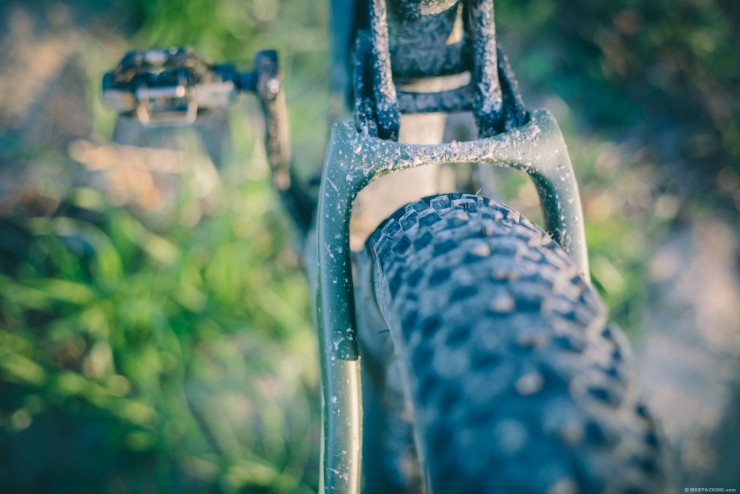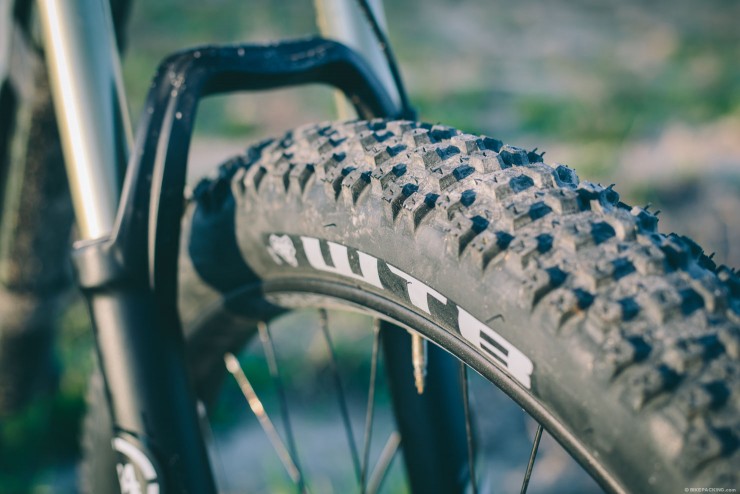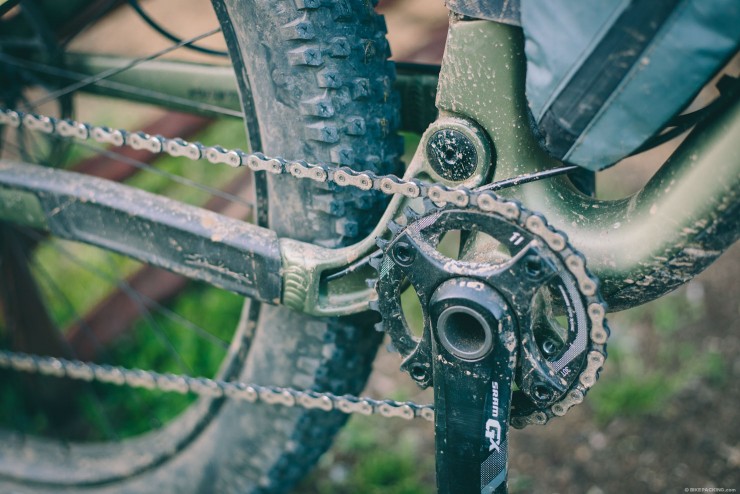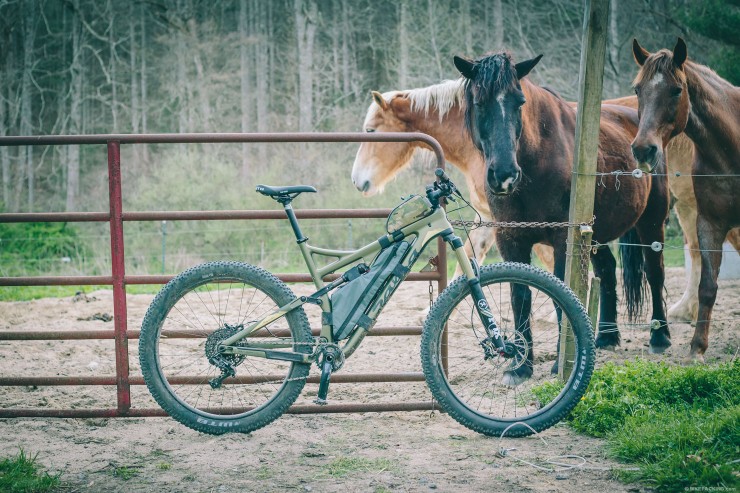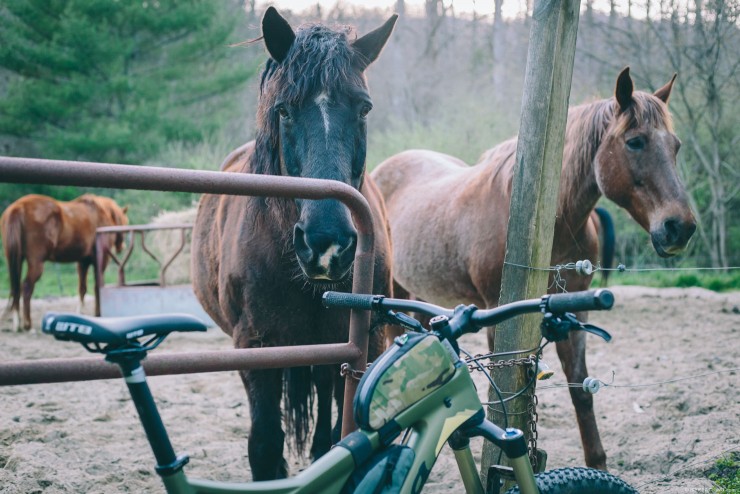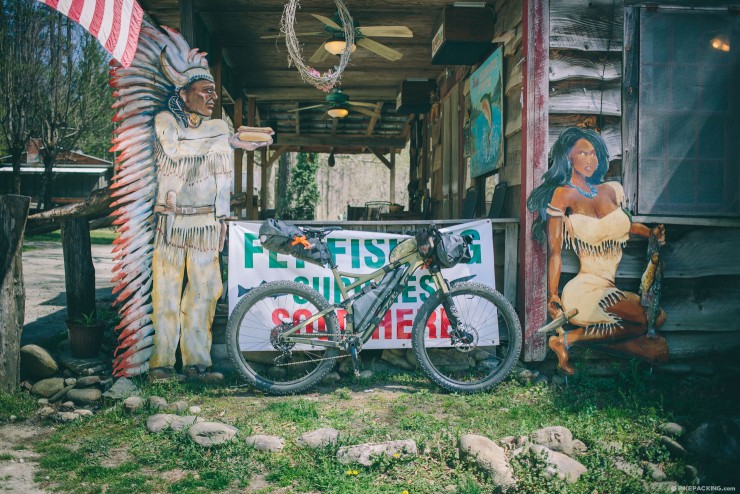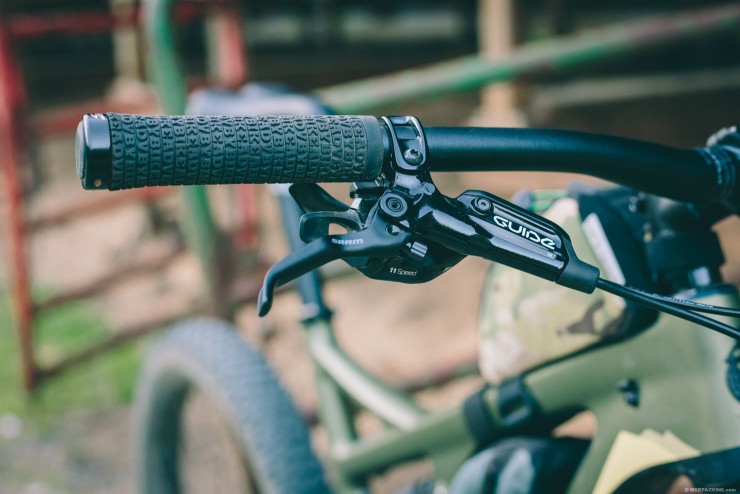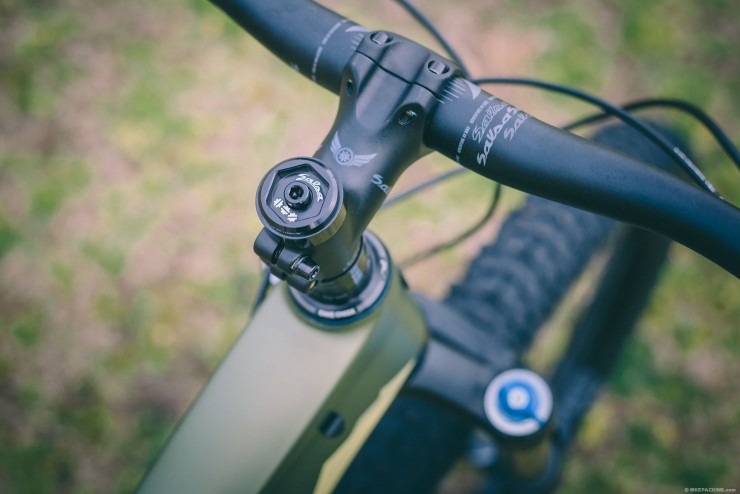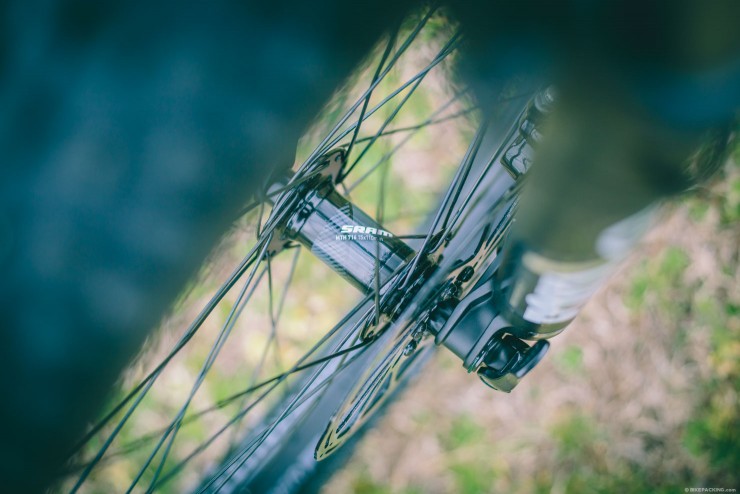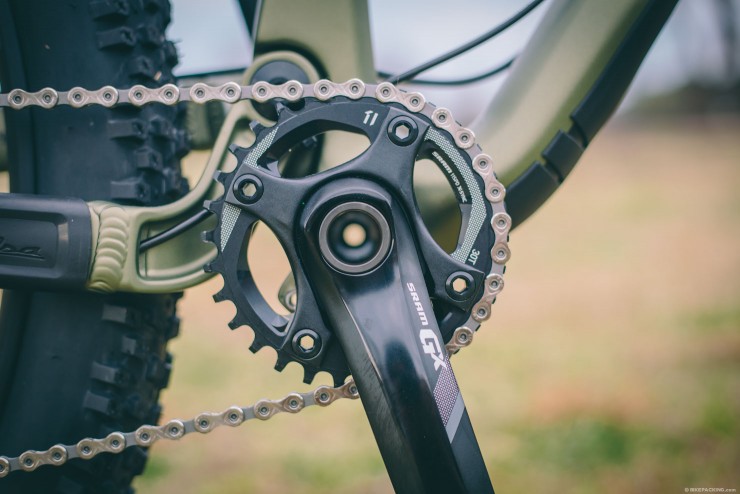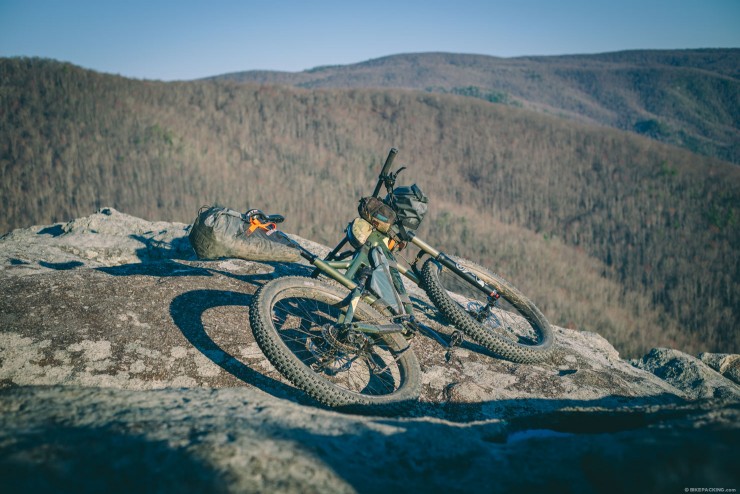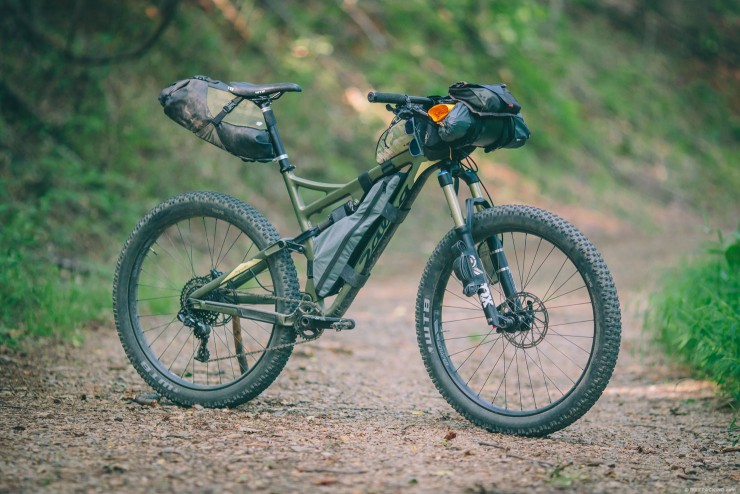Salsa Pony Rustler Review: Smarten up, dumb down.
Share This
Lines ignored. Corners railed. Roots degreased. Rock gardens manicured. Are trails being over-tamed by full-suspension plus tire bikes such as the Salsa Pony Rustler? Preface: this article is one part opinion, two parts review…
A couple weeks ago I darkened the doorway of a small bike shop and caught the tail end of a conversation. It was more of a monologue, really; a young employee was giving his ‘expert’ opinion to a customer that “fat bikes are stupid” and plus bikes — rigs with 2.8-3.2” tires — are just an industry fad for lesser riders who “feel the need to dumb down trails”. We obviously don’t agree. Prior to the 2016 crop, plus bikes didn’t get much mainstream attention, nor reap this type of belittlement. They passed as an eccentricity limited to rigid frames and a mostly older crowd. But now that real full suspension mountain bikes are mutating, shod with wide rims and 3” doughnut rubber, these bikes and their riders are taking jabs. Rocky Mountain even offered a sarcastic take on such slander with the release of their own 27.5+ Pipeline and its ‘Dumbing Down the Shore’ campaign.
So what’s behind this chastisement? Perhaps big tires offer too much traction for the purist mountain biker? I’ve never heard anyone complain about too much traction. Maybe they reduce the margin of error on classic lines? Why then have long-travel bikes not garnered such judgement; do they not make trail riding easier by smoothing out the rough edges? How about dropper seatposts; that’s taking an obstacle out of the equation, no? If any body chooses to deem a rider less-than because of their choice of bicycle, I think the accuser should be limited to a singlespeed 26” rigid bike with 2” tires and a coaster brake. After all, that’s the original criterion on which this sport was built. I kid, but for what it’s worth, I think that as long as there’s not a motor or *ahem* batteries, there’s no such thing as cheating. Whether the onus for ride improvement lies in longer travel, knobbier rubber, fatter tires, more moving parts, or a combination thereof, a mountain bike — no matter the type — is a tool for the style of riding that one wishes to tackle. To each his or her own. It’s evolution, not a battle for the appropriate yardstick of radness.
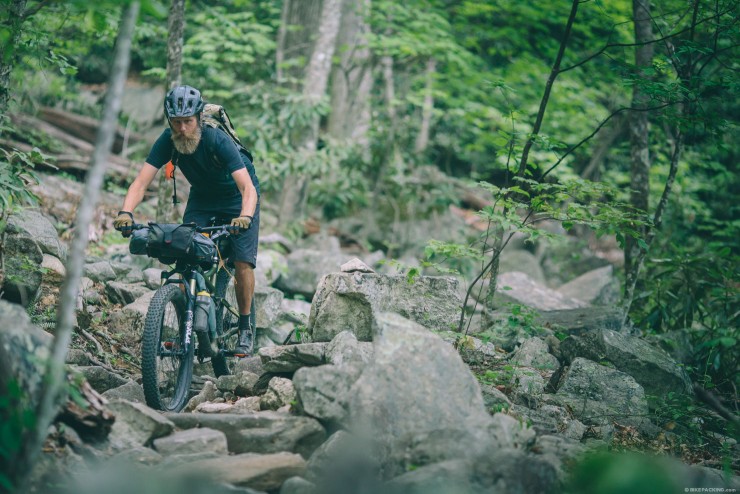
That said, I get it. Bigger tires allow more traction, better rollover and unprecedented stability. They enable us to choose lines a little less carefully. They can boost confidence and may even help riders clean more obstacles, both climbing and descending. Whether plus bikes should be accused of dumbing down trails is just a negative terminology debate, born from machismo perhaps. I’ve ridden a rigid 29+ Krampus as my go-to bike for a few years now, as well as a couple 27.5+ hardtails, and now the full-suspension Salsa Pony Rustler. I personally love the platform. Has it improved my skill level? Yes, absolutely. These bikes have opened up a whole new way of riding that encourages me to pedal what I may have walked in the past. They allow access to more terrain, and make longer days in the saddle more efficient, less taxing, and more interesting. In essence, plus bikes let us travel places we might otherwise miss.
The 29+ platform has been around a while, but 27.5+ is relatively new. Oddly enough, 27.5+ has quickly gained traction in the industry, while only a handful of companies have focused their efforts on 29+. The slightly smaller wheel size is a welcome shift to the plus movement; popular opinion is that it offers a more nimble ride than it’s predecessor, which makes it more approachable to skinny tire converts. Several companies debuted 27.5+ plus hardtails in 2016, but just a handful merged full-suspension with voluminous rubber. Salsa’s Pony Rustler is one that piqued our curiosity. While others took a modest approach with 2.8” tires, Salsa aimed to harness the volume, operating pressure and traction characteristics of the true 3” plus platform. Then, they built a short travel, full-suspension bike around it.
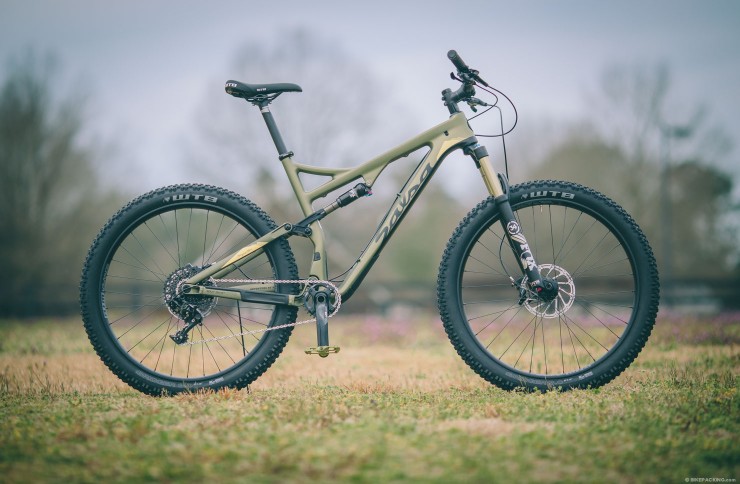
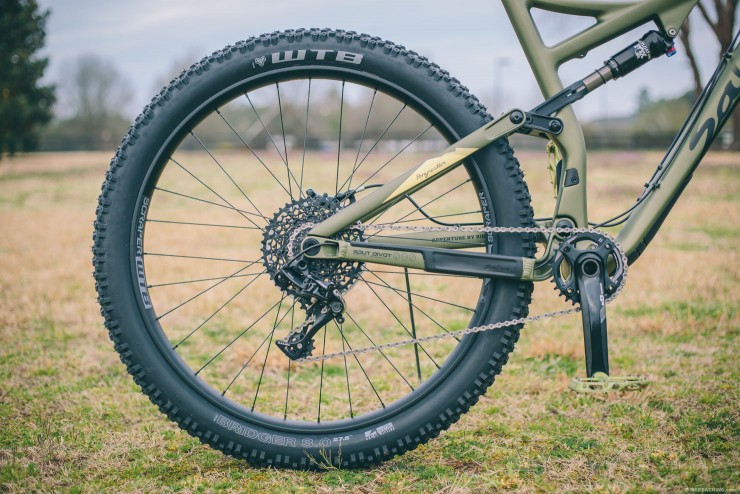
The Salsa Pony Rustler GX1 vs Pisgah
Needless to say, the fear of being mocked by other mountain bikers didn’t hinder my excitement to try the Pony Rustler. So I happily shelved my ego, embraced my average technical riding skills, and spent over three months on this beast. It’s been on four bikepacking trips in the North Carolina Appalachians and tirelessly trail tested in the Pisgah Ranger and Grandfather Districts. There is probably no better place to prove the Pony Rustler. Even as a ‘short-travel’ rig, it’s a lot of bike. With 120mm rear travel and 130mm up front — and the added suspension characteristics of the beefy 3” tires — Salsa built the Pony Rustler for chunky backcountry terrain that warrants added control and traction. Pisgah’s rugged trails are just that — burly rock gardens, steeps, drops, and gnarled roots that are often described as ‘greasy’. To put the cart way before the Pony, this bike excels here. Would the Pony Rustler be too much bike for your average local municipal trail? Probably. But in Pisgah, it helps put the metaphorical bridle on an otherwise unruly horse.
Breaking the Pony
To be honest, the Pony Rustler felt a little off to me initially. Maybe it was the fault of lingering muscle memory that had manifested itself over a winter of riding a rigid 29er. It took an outing or two and some adjustment to dial in the ride and feel I was looking for. At first, I tuned the suspension too soft, with a travel akin to what I’d ridden on 26” full-suspension bikes — based on sag and normal tire pressure. This resulted in a sloppy ride and too many pedal strikes. Eventually I found the ideal setup by introducing a bit more pressure in both the fork and shock, and dropping the PSI in the tubeless tires to the mid to low teens. This gave the bike a nice combination of traction, compression, and stability. It also maximized the suspension, and made it come to life on the trail. Overall Dave Weagle’s Split Pivot suspension design is pretty amazing, and certainly one of the most stable and confident platforms I’ve ridden to date. While loping down craggy and gnarly terrain, the suspension, meaty tires and low tire pressure creates a tour de force that wrangles roots, jagged rocks and off-camber pitches without exception. This combo also keeps small bump chatter to a minimum.
The Pony Rustler holds its ground while climbing as well. Technical ascents are easily tamed with the additional traction and rollover afforded by the chunky tires and a suspension that is surprisingly compliant. That said, I often turned the Trail Mode adjustment dial to the middle position on both the fork and shock to tune the bike for trails with a lot of ups and downs. And the steepest of climbs were no match for the fork or shock whilst in the open/soft setting. Ultimately I preferred to lock them out completely for extended and/or steep climbs. The softer tire pressure compensated perfectly for the loss of suspension these situations.

Meaty tires aside, the Pony Rustler has a spritely geometry. A short chainstay and slack 68.1° head angle coupled with a rather low ~13” bottom bracket makes for a fancy free modern trail geometry. The bike handles beautifully, begs to be pushed and carved on singletrack, and rails corners like a dream. The deep inset riding position afforded by the lower BB offers a stance that’s maneuverable at slow speeds as well.
There are a few other things to note about the bike’s overall design. In addition to the large footprint, the Pony Rustler has a 148 x 12mm axle spacing and BOOST crankset specification. This allows plenty of chain clearance for the big tires and adds to the overall stiffness of the bike. Also, the Pony Rustler frame retains its capacity to run 29 x 2.25-2.4” wheels/tires, which allows riders to toggle between 29 and 27.5+ should they wish.
While Out Bikepacking
For some folks, setting up a full-suspension rig for bikepacking is somewhat frustrating… for good reason. Typically the added weight and baggage affects the ride more so than that of a rigid or hardtail bike. Then there’s the risk of bloated bags rubbing the tires when the suspension is engaged. And, then there’s the limited frame triangle space for a framebag. But, with a bit of fine tuning and attention paid to packed weight, outfitting a suspended rig doesn’t have to be a ride killer. The Pony Rustler can be easily outfitted into the perfect bikepacking rig. First off, it’s a really solid bike. The parts spec is bomber, and the overall stature of the bike feels indestructible. Adding bags and weight didn’t change this. In fact, the Pony Rustler felt at home when loaded down for a three or four day trip. With 10-20psi added to both the shock and fork, bag rub was extremely rare.
On our first couple of outings I employed the larger new Ortlieb bags, which were a little big for a full-sus setup. Later, I mounted a harness in the front and the slimmer Mr. Fusion V2 seat pack. This setup had no issues whatsoever. In addition, the large Pony Rustler has an ample frame triangle that allowed a custom made framebag to carry the camp kitchen, rain gear and a few other odds and ends. When not donning a framebag, the same triangle fits a full-sized water bottle.
It’s also worth elaborating on Salsa’s choice of tires in the bikepacking context. The fairly aggressive WTB Bridgers are on the heavier end of the plus tire spectrum — 1207g. However, so far they’ve proven extremely durable. The Bridgers have a stout feel, incredible cornering prowess and bar-none traction. They don’t feel as sluggish as one might guess by their looks. All of their good traits might just be a result of the thicker than normal casing. Thier hefty casing also proved worthy when the bike was loaded. Even at lower pressures, the tires still felt solid in the corners with no folding to speak of.
Build Kit
Salsa rolled out the Pony Rustler GX1 with a choice and generally sturdy built kit. Everything down to the short Salsa Guide stem feels like it was handpicked for where and how the bike was intended to be ridden. The GX1 drivetrain is fairly snappy and the SRAM Guide R brakes are equally impressive. If I had to find one complaint it would be in the 32 tooth chainring. Strictly from a bikepacking perspective, I’d prefer a direct mount 28 or 30 for steeper terrain.
Frame
- Frame: Pony Rustler Carbon, Army Green (Large)
- Fork: Fox Float 34, 27.5+ x 110, 130mm
- Shock: Fox Float Performance (120mm)
Drivetrain
- Crankset: SRAM GX, 30t, BOOST
- Derailleur (rear): SRAM GX 11Sp
- Shifter Rear: SRAM GX1
- Cassette: SRAM GX1, 11sp, 10-42T
- Chain: KMC X11
- Bottom Bracket: PressFit 41x92mm w/ISCG05 Tabs
Components
- Hub (front): SRAM MTH 716 110mm, WTB Scraper i45 TCS
- Hub (rear): SRAM MTH 746 148mm, WTB Scraper i45 TCS
- Rims: WTB Scraper i45 TCS, tubless
- Spokes: DT Swiss Competition, butted, black
- Tires: WTB Bridger 27.5 x 3.0, TCS
- Brakes: SRAM Guide R, 180mm rotors
- Handlebar: Salsa Rustler 2, 750mm
- Grips: Salsa Backcountry Lock-on
- Stem: Salsa Guide
- Headset: Cane Creek 40 ZS44/28.6, ZS56/40
- Seatpost: Truvativ T20, 0mm offset
- Saddle: WTB VoltComp
Pros
- Solid and stable 27.5+ platform that excels on difficult terrain.
- Completely dialed Split Pivot suspension design and stiff chassis.
- Build kit/value: The high end carbon frame and excellent build kit make the Salsa Pony Rustler GX1 a pretty good value at $4,500.
- Gearing is great for light bikepacking, although some might complain that it runs out a bit early for trail riding.
- The paint and graphics scheme are really nice.
Cons
- No downtube bottle bosses; in my opinion, any ‘adventure’ bike should be equipped these… but many don’t.
- For ‘bigger’ all-mountain riding the 120/130mm travel might feel a little limiting to some.
- Model Tested Salsa Pony Rustler GX1 (carbon)
- Size Tested Large (20″)
- Sizes Available Small, Medium, Large, X-Large
- Weight (as tested) 30.5lbs (13.85kg)
- Price $4,499
- Contact SalsaCycles.com
- Recommended Uses Trail riding, backcountry bikepacking, Singletrack weekenders.
Wrap Up
Some might say that the mountain bike industry landed on the 2.25” tire standard by chance. Perhaps this standard isn’t founded on reason, nor is it the best; it just ended up that way based on manufacturing techniques and historical firsts. For years this standard hasn’t really been challenged, until now. Maybe 2.25” isn’t what all trails should be measured by. I see plus tires not as an industry forced gimmick, but as an evolution of what the mountain bike can be.
Salsa has embraced the challenge of making this new platform viable, and the Pony Rustler is an shining example of what plus sized tires are all about. Through the fusion of the well engineered Split Pivot short-travel suspension system, a solid trail geometry, and the traction and control of plus tires, they’ve created a machine that does backcountry singletrack really well. It’s a rugged trail machine that’s fun to ride and built like a tank, yet still light enough to be playful. The Pony Rustler seems to beg for craggy trails, rough and wild terrain, and challenging conditions. With a great build kit and carbon frame, the GX1 model makes for an excellent choice as a go-to, go-anywhere trail bike.
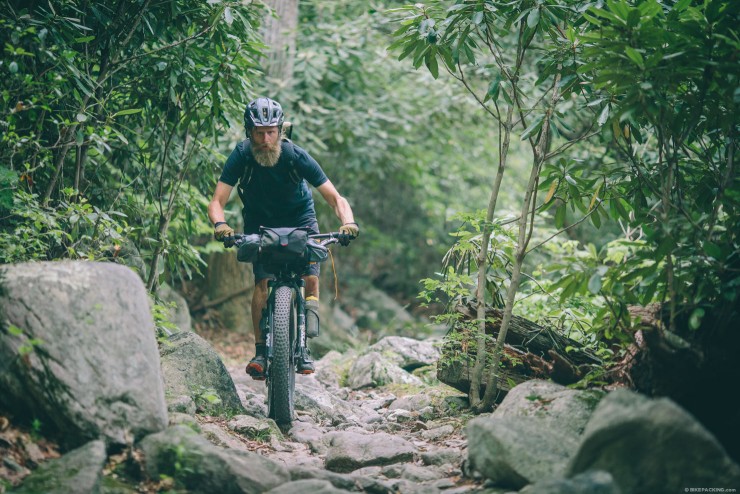
Rider’s Background
Between big trips, I can usually be found riding my favorite trails in Pisgah, NC, or tacking together 4 or 5 day bikepacking trips throughout the eastern US and beyond. This past winter, Gin and I designed and rode the Trans-Uganda and Altravesur bikepacking routes.
Height: 6’0”
Weight: 170 lbs
Inseam: 33”
Disclosure
The Salsa Pony Rustler was provided for testing and review.
Please keep the conversation civil, constructive, and inclusive, or your comment will be removed.






